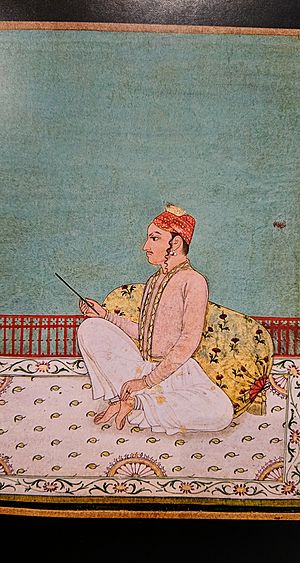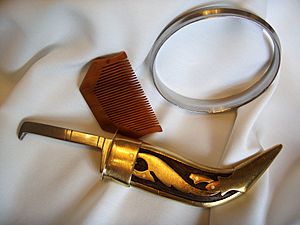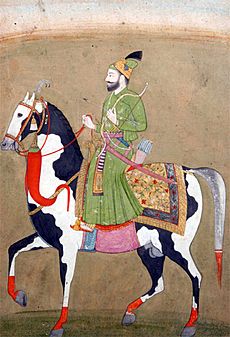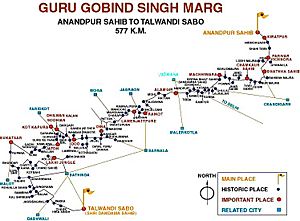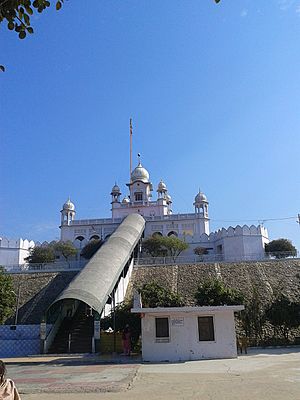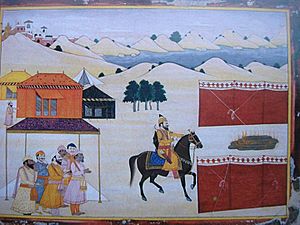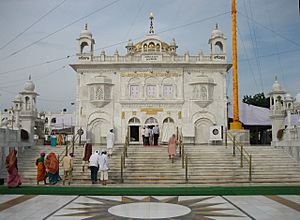Guru Gobind Singh facts for kids
Quick facts for kids Guru Gobind Singh |
|
|---|---|
| ਗੁਰੂ ਗੋਬਿੰਦ ਸਿੰਘ | |
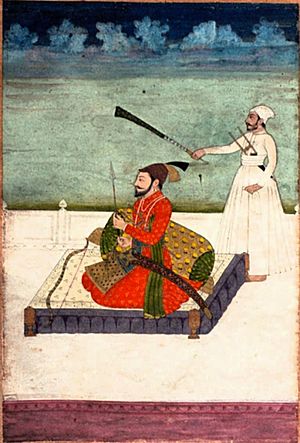
Contemporary painting of Guru Gobind Singh (seated) found within a Dasam Granth manuscript of Anandpur Sahib
|
|
| Religion | Sikhism |
| Known for |
Fought the following Battles :
|
| Other names | Tenth Nanak Tenth Master |
| Personal | |
| Born | Gobind Rai 22 December 1666 Patna Sahib, Bihar Subah, Mughal Empire |
| Died | 7 October 1708 (aged 41) Hazur Sahib, Bidah Subah, Mughal Empire |
| Cause of death | Assassination |
| Spouse | Mata Jito Mata Sundari Mata Sahib Devan |
| Children |
|
| Parents |
|
| Religious career | |
| Predecessor | Guru Tegh Bahadur |
| Successor | Guru Granth Sahib |
| Signature | 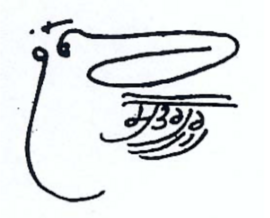 |
Guru Gobind Singh (born Gobind Das or Gobind Rai; 22 December 1666 – 7 October 1708) was the tenth and last human Sikh Guru. He was a great spiritual leader, a brave warrior, a talented poet, and a deep philosopher. When his father, Guru Tegh Bahadur, was killed by the Mughal emperor Aurangzeb, Gobind Singh became the leader of the Sikhs at just nine years old. Sadly, all four of his sons died during his lifetime. Two were killed in battle, and two were executed by the Mughal governor, Wazir Khan.
Guru Gobind Singh made many important contributions to Sikhism. In 1699, he created the Khalsa, a special community of Sikh warriors. He also introduced the Five Ks, which are five articles of faith that Khalsa Sikhs always wear. He is also known for the Dasam Granth, a collection of hymns that are a sacred part of Sikh prayers. Most importantly, he finalized and declared the Guru Granth Sahib as the eternal Guru for Sikhs, making it their main holy book.
Contents
Early Life and Family

Gobind Singh was the only son of Guru Tegh Bahadur, who was the ninth Sikh Guru, and Mata Gujri. He was born in Patna, Bihar, on 22 December 1666. At that time, his father was traveling in Bengal and Assam. The place where he was born and lived for his first four years is now a special shrine called Takht Sri Patna Harimandar Sahib.
In 1670, his family moved back to Punjab. In March 1672, they settled in Chakk Nanaki, a town in the Himalayan foothills. There, young Gobind Rai received his education.
Becoming the Guru
In 1675, Kashmiri Pandits, a group of Hindu scholars, asked Guru Tegh Bahadur for help. They were being unfairly treated by Iftikar Khan, the Mughal governor of Kashmir, under Emperor Aurangzeb. Guru Tegh Bahadur decided to meet Aurangzeb peacefully. However, his advisors warned him that it might be dangerous.
Young Gobind Rai, who would later be known as Guru Gobind Singh, told his father that he was the most worthy person to make such a sacrifice. His father went to meet Aurangzeb but was arrested. On 11 November 1675, he was publicly executed in Delhi. This happened because he refused to convert to Islam and because of the ongoing conflicts between Sikhs and the Mughal Empire. Before he died, Guru Tegh Bahadur wrote a letter to Gobind Rai. This letter, called Mahalla Dasven, is now part of the Guru Granth Sahib. After his father's death, Gobind Rai became the tenth Sikh Guru on 29 March 1676, during the Vaisakhi festival.
Education and Marriages
Guru Gobind Singh continued his education even after becoming the Guru. He learned to read and write, and he also trained in martial arts like horse riding and archery. He learned Farsi in just one year. By the age of six, he started his martial arts training.
In 1684, he wrote the Chandi di Var in Punjabi. This text tells a story of a legendary war between good and evil. It shows how good stands up against injustice and unfair rule. This story is based on an ancient Sanskrit text called Markandeya Purana. He lived in Paonta, near the Yamuna river, until 1685.
Guru Gobind Singh had three wives:
- At age 10, he married Mata Jito on 21 June 1677. They had three sons: Jujhar Singh (born 1691), Zorawar Singh (born 1696), and Fateh Singh (born 1699).
- At age 17, he married Mata Sundari on 4 April 1684. They had one son, Ajit Singh (born 1687).
- At age 33, he married Mata Sahib Devan on 15 April 1700. They had no children, but she played a very important role in Sikhism. Guru Gobind Singh called her the Mother of the Khalsa.
Guru Gobind Singh's life and leadership were very important for Sikhs. He created the Khalsa, which means "Pure Ones." This group played a key role in protecting Sikhs for a long time, even after his death. They helped during many invasions and wars.
Founding the Khalsa

In 1699, Guru Gobind Singh asked all Sikhs to gather at Anandpur during the Vaisakhi festival. According to Sikh tradition, he asked for a volunteer. One person came forward, and the Guru took him into a tent. The Guru then came out alone with a bloody sword. He asked for another volunteer and repeated this four more times. After the fifth volunteer went into the tent, the Guru returned with all five volunteers, who were all safe. He called them the Panj Pyare, meaning "Five Beloved Ones." They were the first members of the Khalsa.
Then, Guru Gobind Singh mixed water and sugar in an iron bowl. He stirred it with a double-edged sword to make what he called Amrit (meaning "nectar"). He gave this Amrit to the Panj Pyare, while reciting prayers from the Adi Granth. This was the start of the khande ka pahul, the baptism ceremony for the Khalsa. The Guru also gave them the new last name "Singh" (meaning "lion"). After the first five Khalsa were baptized, the Guru asked them to baptize him as a Khalsa. This made the Guru the sixth Khalsa, and his name changed from Guru Gobind Rai to Guru Gobind Singh. This new ceremony replaced an older ritual where people would drink water that the Guru had touched with his toe.
Guru Gobind Singh also started the tradition of the Five K's for the Khalsa:
- Kesh: Uncut hair.
- Kangha: A small wooden comb.
- Kara: An iron or steel bracelet worn on the wrist.
- Kirpan: A small sword.
- Kacchera: Special short breeches.
He also set rules for Khalsa warriors. For example, they were not allowed to use tobacco or eat 'halal' meat. The Khalsa also agreed not to associate with rivals of the Guru. The fact that men and women from different social classes were all initiated into the Khalsa showed that Sikhism believed in equality for everyone, no matter their background or gender.

Guru Gobind Singh's actions were very important for the Sikh tradition. He created the Khalsa, which helped Sikhs resist the persecution by the Mughal Empire. He continued to defend dharma, which means true religion, against Aurangzeb's attacks. He also introduced ideas that challenged unfair taxes by the Mughals. For example, Aurangzeb made non-Muslims pay taxes like the jizya (a tax on non-Muslims) and a pilgrim tax. There was also a Bhaddar tax for Hindus who shaved their heads after a loved one died. Guru Gobind Singh said that Khalsa Sikhs did not need to follow this practice. This meant Sikhs living in Mughal areas didn't have to pay these taxes.
The new rules for the Khalsa did cause some disagreements among Sikhs in the 18th century. Some Sikhs who followed the older ways, called Nanakpanthi, had different views from the Khalsa. Guru Gobind Singh deeply respected the Khalsa. He said that there was no difference between the True Guru and the sangat (the community). Before the Khalsa, Sikhs were called Sisya (disciples). After the Khalsa, the preferred term became Khalsa.
Also, before the Khalsa, Sikh communities had leaders called Masands who collected donations. Guru Gobind Singh realized that the Masands system had become corrupt. He ended it and created a more organized system directly supervised by the Khalsa. This led to two groups of Sikhs: those who became Khalsa and those who remained Sikhs but did not get baptized. The Khalsa Sikhs saw themselves as a distinct religious group, while the Nanakpanthi Sikhs kept their own traditions.
The Khalsa warrior community started by Guru Gobind Singh continues to this day. Initiated Sikhs are called Khalsa Sikhs, while those who are not baptized are called Sahajdhari Sikhs.
Sikh Holy Books
Sikh tradition credits Guru Gobind Singh with finishing the Guru Granth Sahib, the main holy book of Sikhism. The final version included the writings of his father, Guru Tegh Bahadur. Guru Gobind Singh declared this text to be the eternal Guru for all Sikhs.
Guru Gobind Singh is also linked to the Dasam Granth. This is another important religious text. Some Sikhs consider it a second holy book, while others have different views on its authority. The standard edition of this book has 1,428 pages and 17,293 verses. The Dasam Granth includes hymns, stories from Hindu texts, writings that celebrate the feminine, an autobiography, and letters to people like the Mughal emperor. It also discusses warriors and theology.
According to a text written in 1755, Sikhs asked Guru Gobind Singh to combine the Dasam Granth with the Guru Granth Sahib. Guru Gobind Singh replied, "This is the Adi Guru Granth; The root book. That one (Dasam Granth) is only for my diversion. Let this be kept in the mind and let the two stay separate."
Parts of the Dasam Granth, like the Jaap Sahib, Tav-Prasad Savaiye, and Benti Chaupai, are important for Khalsa Sikhs. They are used in daily prayers (Nitnem) and in the Khalsa initiation ceremony.
Wars and Conflicts
After Guru Tegh Bahadur's execution, the Mughal Empire under Aurangzeb became very hostile towards Sikhs. Guru Gobind Singh led the Sikhs in resisting this hostility. The conflicts between Muslims and Sikhs were at their peak during this time. Aurangzeb even ordered the extermination of Guru Gobind Singh and his family.
Guru Gobind Singh believed in Dharam Yudh, which means a war fought to defend what is right. He believed such a war should only be fought as a last resort. It should not be for revenge, greed, or destruction. For Guru Gobind Singh, one must be ready to die to stop unfair rule, end persecution, and protect one's religious values. He led fourteen wars with these goals. He never took prisoners or damaged places of worship.
Key Battles
Guru Gobind Singh fought many battles against the Mughal Empire and the kings of the Siwalik Hills. Here are some important ones:
- Battle of Bhangani (1688): This battle happened when Fateh Shah and his mercenary commanders attacked Guru Gobind Singh's forces without reason. The Guru was helped by his maternal uncle, Kripal, and a Brahmin named Daya Ram.
- Battle of Nadaun (1691): Guru Gobind Singh, along with other Hindu kings, defeated the Islamic armies of Mian Khan and Alif Khan. This happened because the non-Muslims refused to pay taxes to the Islamic officials.
- Battle of Guler (1696): The Guru teamed up with the Hindu king of Guler to defeat the Muslim army.
- Battle of Anandpur (1700): The Mughal army of Aurangzeb attacked with 10,000 soldiers. Guru Gobind Singh fought directly and defeated the Mughal commander.
- Battle of Nirmohgarh (1702): This battle lasted two days with heavy losses on both sides. The Mughal army eventually left the battlefield.
- Battle of Basoli (1702): The Guru was supported by Raja Dharampul of Basoli. The battle ended with a peace agreement.
- First Battle of Chamkaur (1702): The Mughal Army was pushed back.
- Second Battle of Anandpur (1704): This battle started because there were many armed Sikhs in Anandpur, leading to a shortage of supplies. The Sikhs had to raid local villages, which angered the local kings. The Mughals then laid a long siege on Anandpur, cutting off supplies. Some Sikhs left the Guru during this siege but later returned and fought bravely. Eventually, the Guru and his followers accepted an offer of safe passage from Aurangzeb. However, as they left, they were attacked.
- Battle of Sarsa (1704): The Mughal commander, Wazir Khan, had promised safe passage to Guru Gobind Singh and his family. But when the Guru left, Wazir Khan attacked them. Many Sikhs died, especially while crossing the Sarsa river.
- Battle of Chamkaur (1704): This is one of the most important battles in Sikh history. The Guru's two elder sons, Ajit Singh and Jujhar Singh, along with many other Sikh soldiers, were killed in this battle.
- Battle of Muktsar (1705): This was the last battle led by Guru Gobind Singh. His army was attacked again by Wazir Khan's forces. Many Sikhs died, including the famous Chalis Mukte (the "forty liberated ones"). The battle site was later renamed Mukt-sar, meaning "lake of liberation," to honor those who died for freedom.
Later Years
After the Second Battle of Anandpur in 1704, the Guru and his remaining soldiers moved and stayed in different places. They even hid in places like the Machhiwara jungle. He stayed with relatives or trusted Sikhs in various parts of India.
The Zafarnama Letter
Guru Gobind Singh saw the Mughal army's actions against his family and people as a betrayal. After all his children were killed and the Battle of Muktsar, the Guru wrote a strong letter in Persian to Aurangzeb. This letter was called Zafarnama, meaning "epistle of victory."
The Guru's letter was firm but also aimed at finding a solution. He criticized the Mughal Emperor and his commanders for their lack of morality in ruling and in war. The letter predicted that the Mughal Empire would soon end because it was full of unfairness and lies. The letter showed Guru Gobind Singh's strong belief in justice and dignity.
Death of Family Members
Guru Gobind Singh's four sons, known as Chaar Sahibzaade (the four princes), died during his lifetime. His two elder sons died in battle, and his two younger sons were executed by the Mughal governor of Sirhind.
The Guru and his two elder sons escaped the siege of Anandpur in December 1704 and reached Chamkaur. However, a large Mughal army followed them. In the battle that followed, Guru's elder sons, Sahibzada Ajit Singh (aged 17) and Jujhar Singh (aged 13), fought bravely. But the Mughal army was much larger. While the Guru was taken to safety, his elder sons were killed in the Battle of Chamkaur in December 1704.
Guru's mother, Mata Gujri, and his two younger sons got separated from the Guru after escaping the Anandpur siege. They were later arrested by the forces of Wazir Khan, the Mughal governor of Sirhind. The younger sons, Sahibzada Fateh Singh (aged 6) and Zorawar Singh (aged 9), were imprisoned in a cold tower. Around 26 and 27 December 1704, they were offered safety if they converted to Islam, but they refused. Wazir Khan then ordered them to be bricked alive in a wall. Mata Gujri fainted when she heard about her grandsons' death and died soon after.
His adopted son, Zorawar Singh Palit, died in 1708 near Chittorgarh Fort in a small fight.
Sikh historians say that Guru Gobind Singh accepted the sad news about his sons' deaths calmly. He is said to have written, "What use is it to put out a few sparks when you raise a mighty flame instead?"
Final Days
Aurangzeb died in 1707, and his sons immediately began fighting for power. Guru Gobind Singh supported Bahadur Shah in the Battle of Jajau. Bahadur Shah, the new emperor, invited Guru Gobind Singh to meet him in the Deccan region of India. Guru Gobind Singh hoped to get his former stronghold, Anandpur, back. He stayed near the emperor's camp for almost a year. However, his requests to get his lands back were not successful. Bahadur Shah kept delaying, as he didn't want to upset either the Guru or the local kings.
Wazir Khan, a Muslim army commander and the Nawab of Sirhind, had fought many wars against the Guru. He hired two Afghans, Jamshed Khan and Wasil Beg, to follow the Guru's army and assassinate him. They secretly followed the Guru's troops, who were camped near the Godavari river. They managed to reach the Guru, and Jamshed Khan stabbed him twice, causing a fatal wound at Nanded. Some scholars believe the assassin might not have been sent by Wazir Khan, but by the Mughal army nearby.
The Guru fought back and killed the assassin. The assassin's companion was killed by Sikh guards when he tried to escape. Guru Gobind Singh died from his wounds a few days later, on 7 October 1708. His death led to a long and difficult war between the Sikhs and the Mughals.
According to a text written in 1768, the Guru's last words were, "The Granth is the Guru and it will bring you to Akal. The Guru is the Khalsa and the Khalsa is the Guru. The seat has been given to Sri Sahib Mata Devi. Love each other and expand the community. Follow the words of the Granth. The Sikh that follows Sikhi shall be with the Guru. Follow the conduct of the Guru. Always remain with Waheguru."
See also
 In Spanish: Gurú Gobind Singh para niños
In Spanish: Gurú Gobind Singh para niños
- List of places named after Guru Gobind Singh
- The 52 Hukams of Guru Gobind Singh
- Bhai Jiwan Singh
- Banda Singh Bahadur



